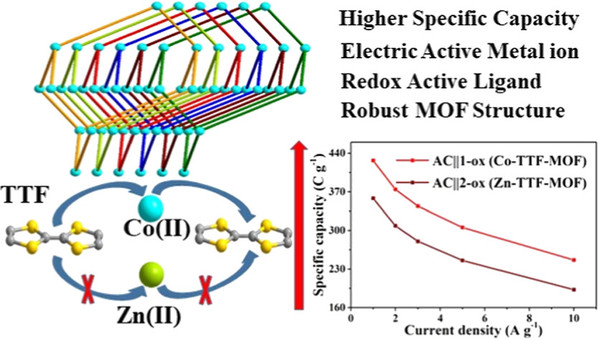Robust Redox-Active Tetrathiafulvalene–Cobalt Metal–Organic Frameworks for Supercapatteries with Promoting Electrochemical Performances
Yu-Chuan Tan, Ruo-Nan Wang, Wei Liu, Jun-Die Zhang, Zi-Yi Wang, Jie Dai, Qin-Yu Zhu(朱琴玉)*
College of Chemistry, Chemical Engineering and Materials Science, Soochow University, Suzhou 215123,P. R. China
Inorg. Chem.2025, 64, 12, 6023–6031
Abstract:Integrating abundant electroactive sites and redox reactions into stable metal–organic framework (MOF) electrodes is an effective and relatively unexplored approach to improve the performance of emerging supercapatteries. In this study, electroactive Co(II) was chosen to coordinate with a redox-active tetrathiafulvalene (TTF) ligand to construct a new MOF, formulated as [Co(TTF(py)4)(BDC)] (1) (TTF(py)4 is tetra(4-pyridyl)-TTF and H2BDC is terephthalic acid). Crystallographic characterization indicated that 1 possesses a three-dimensional 6-fold interpenetrating diamond-like topology with high crystal density. Isostructural [Zn(TTF(py)4)(BDC)] (2) was also synthesized to explore the effect of metal ions on the performance of supercapatteries. When directly used as an electrode material in a 3-electrode system, the iodine-treated MOFs 1 and 2 (namely 1-ox and 2-ox, respectively) electrodes exhibit battery-type performance and high capacities. The specific capacities are 1072.2 and 857.8 C g-1 at 1 A g-1 for 1-ox and 2-ox, respectively. The AC||1-ox supercapattery device presents a specific energy of 100.8 Wh kg-1 at a specific power of 0.975 kW kg-1. Ex situ characterizations and theoretical calculations revealed that the excellent performance of 1-ox originates from the synergistic effect of the robust topology, Co(II) metal centers, and ligand dominant mechanism.

Article information: //doi.org/10.1021/acs.inorgchem.4c05091